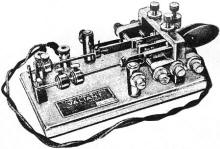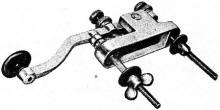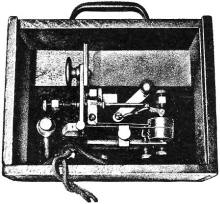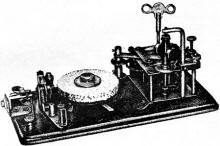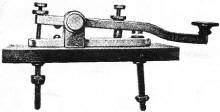The Dit Makers
|
|
A lot of innovation went into perfecting telegraph keys. The earliest keys were the familiar "straight key" tapping type where the operator uses a single finger to close a set of contacts that "keyed" the transmitter for a burst of RF energy. The length of each "dit" or "dah" was determined by the operator's dwell time. It didn't take long for someone to improve on the scheme by designing keys that assured an adjustable, constant length for a dit or a dah. Poor quality transmitters with lousy rising and falling edge signatures at the beginning and end, respectively, of a CW (continuous wave) pulse made matters worse. Constant length bursts make it easier for the person on the receiving end to copy since patterns do not depend so much on the sender's "fist" style. Eventually the electrical, mechanical, and human elements got good enough that code sending / receiving speed was limited by the amount of time taken to physically open and close the key contacts. A stronger return spring makes the contacts open faster, but it is harder to depress and slows operation. Horace Greeley Martin, proprietor of the Vibroplex Company, introduced the "bug" style telegraph key in 1905 to address the issue. The Vibroplex has a set of contacts on both sides of a paddle that moves back and forth horizontally between the user's thumb and forefinger. That removed the need for a strong spring (only enough force to center the paddle) and allowed the operator to very rapidly shake his wrist to generate code. A newer type bug, referred to as a paddle, has adjustable circuitry that generates fixed proportion dits, dahs, and spaces. They are referred to as "iambic" due to the fixed meter (cadence) generated. The Dit Makers -Converting Muscle Power to Morse Code Was the Job of These Old Workhorses By Marshall Lincoln Although this statement may start an argument, the heyday of the radiotelegrapher has passed. Since Marconi keyed his first transmitter, however, there have been all sorts of ingenious contraptions developed to ease the job of the radio operator. Looking back, many key designs now seem rather foolish and scarcely worth the effort involved in learning how they were to be used. You'll find old keys, proudly polished , exhibited in the many "wireless" museums that dot the country. The keys shown here are on display in the museum maintained by the American Radio Relay League, in Newington, Conn.
Posted April 10, 2018 |
|

